How to choose a floor-standing air conditioner: tips for choosing + review of the best models
Climate control equipment continues to gain popularity among owners of apartments and cottages.There is a choice between devices installed indoors and mechanisms partially located outside them.
A striking representative for indoor installation is a mobile floor-mounted air conditioner that creates comfort and a healthy microclimate. Let's find out what to look for when choosing a model.
The content of the article:
What are the benefits of floor standing air conditioners?
Depending on the layout, size of the apartment, and the required power of the device, you are given the opportunity to choose between stationary and mobile devices.
We are interested in the second group, namely portable floor air conditioners, the installation and connection of which are usually carried out independently.
They belong to evaporative type devices and consist of the following elements:
- electric motor operating from a 220 V network;
- a fan, the speed of the blades of which determines the amount of supplied air;
- a filter saturating pump with drain and water supply valves;
- evaporative filters made of polymers and cellulose, resembling honeycombs and enclosed in plastic frames;
- water tray.
All parts are packaged in a plastic or metal case, the durable material of which can withstand changes in temperature and humidity and does not deform when moved from one place to another.

If you regularly change the filters, the devices effectively clean the air in the room, remove dust, and help create a healthy microclimate without excess humidity.
Sometimes such a unit is a salvation for a person suffering from allergies or asthma.

However, you also need to remember the disadvantages. Among them are a fairly high noise level, free space for installation and the presence of drafts, which are inevitable if the wrong model is chosen.

Let's look at both options to find out their fundamental differences.
Basics of Choosing a Ductless Model
Stylish, easy to use, mobile, with a modern design, an air conditioner without an air duct looks more attractive than a model with a thick hose, and even more so than “industrial” designed suspended ceiling devices.
For this reason, it is predominantly chosen by women. However, behind the beautiful body there are often quite noticeable pitfalls hidden. Let's look at the strengths and weaknesses of the device.
What criteria should you pay attention to?
First, let's find out how a mobile floor air conditioner that is not equipped with an air duct works.It is also called an evaporative type device: warm air passes through a system of filters (one of which is a sponge soaked in water) and, interacting with a moist environment, cools to the required temperature.

If you want the air to be cool and fresh, running the air conditioner alone is not enough. It is necessary to ensure sufficient air flow, in fact - to arrange supply and exhaust ventilation. Then you will forever forget what stuffiness, stale air, the smell of dust or mold are like.
If you decide to choose a mobile model, pay attention to the following characteristics:
- power and performance;
- additional functions (heating, drying, multi-level filtration);
- body dimensions;
- control method;
- energy efficiency class.
Power consumption in different modes (cooling and heating) may differ, but it rarely goes beyond 1-2 W. This means that for a room of 20-25 m2, a device with a power of 1-1.5 W is sufficient.
We recommend reading our other article, where we described in detail how to calculate the power of an air conditioner. More details - go to link.
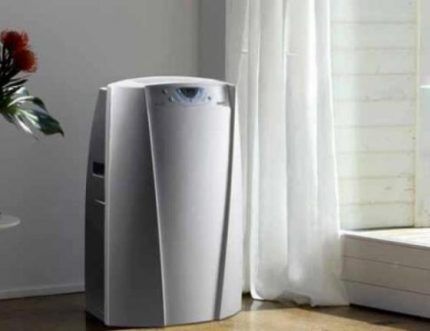
Not all models have additional options.Simple air conditioners are easily recognized by their low cost; the relationship is simple: the more features, the higher the price.
Not all models have a heating mode and a drying mode. Drying is necessary when air humidity is higher than normal - this applies to coastal regions. In central Russia and northern Russia, the air is already quite dry. But heating is a useful function that is usually used in the off-season.
Modern devices have a convenient control panel at the top of the case, many are equipped with a remote control. Using the remote control or buttons, you can adjust the fan speed, select a special mode, and set the desired temperature. Many models are equipped with a timer with which you can program delayed on/off.
Energy efficiency class is an indicator that worries almost everyone. If you want to save money, choose a class A model (the maximum possible is A+++).
Read more about choosing floor-mounted ductless air conditioners Further.
Features of indoor installation
At first glance, there should be no special requirements for installing a compact device. In fact, even a mini air conditioner on wheels that can be moved from room to room requires certain conditions.
One of the requirements is a sufficient area of the room, which must be correlated with the power of the device: for every 10 m² approximately 1 W.
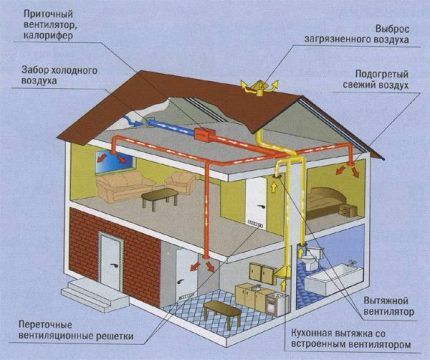
The mobile unit requires constant maintenance, which consists of filling a special reservoir with water. A low water level is usually indicated by an indicator. If the air conditioner constantly operates at maximum mode, water must be added frequently.
However, if you compare the portable model with similar devices equipped with an air duct, its installation is much simpler. In fact, it is enough to unpack the device and install it on a horizontal surface, in any corner of the room.
Connection and configuration are carried out according to the instructions, but take a minimum of time and effort. Let's assume that installation of split systems will require several hours and the help of specialists.
All about ducted air conditioners
The only external difference between devices with air ducts is the presence of a large-diameter corrugated pipe through which warm air is discharged out of the window. However, the difference is not only about design.
Analysis of technical characteristics
In terms of production capacity, floor-standing models with an air duct are not much different from their simpler counterparts: they are also designed for cooling (or heating) rooms with an area of 20-25 m², less often - 30 m². This limitation is due to size, noise from the compressor and load on the electrical network.

The built-in compressor creates noise, the level of which can reduce the comfortable stay in the room. When choosing, you should focus on 45 dB, but the values of most modern models, unfortunately, are 50-60 dB.
Dimensions are selected depending on installation capabilities. For large rooms, it is better to choose devices with a large body.As a rule, they are multifunctional and have increased productivity.
If you plan to move the device often, a compact mini-model with wheels is suitable. Do not forget that each installation location requires a separate opening for the air duct.

Let’s move on to the point that distinguishes ducted air conditioners – their installation.
Device connection features
The main guide you should read before installation is the manufacturer's instructions. It lists the requirements for the room and the procedure for installation, and also presents diagrams and drawings. And we will look at the question of where and how the air duct is connected.
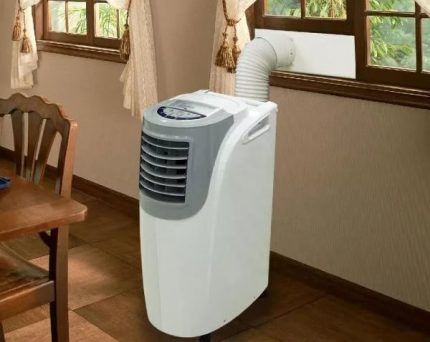
There are three ways to take the pipe out:
- through a window (window or specially made hole);
- into a hole in the wall;
- into the ventilation shaft.
Installation in ventilation duct sometimes associated with structural difficulties. The standard length of the air duct is no more than 2 m, while the distance to the shaft entrance is usually greater. Making large holes in the walls of high-rise buildings is strictly prohibited; there remains only one solution - a window.
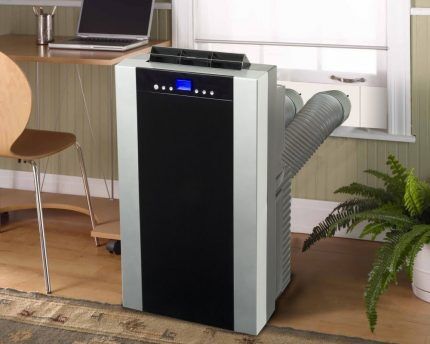
Why is it not enough to simply place the hose on the lower partition of the window? Hot air from the room will go out the window, mix with the fresh flow and partially return back.
The effect will be minimal. To prevent exhaust air masses from returning through the opening, the window vent or window opening must be modified.
Usually, the free space is simply covered with a plastic partition, in the center of which a hole is cut to fit the diameter of the hose. To protect the hose from friction against plastic, use a smooth short pipe or a silicone (rubber) cuff.
When the mobile device is moved to another room, the hole is covered with a plug. Companies that sell air conditioners usually offer all kinds of accessories - plugs, frames with doors, special panels.
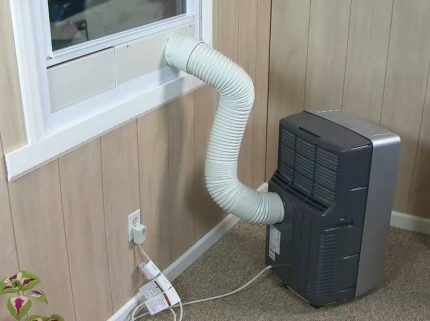
If the hole for the air duct is in order, all that remains is to install and connect the air conditioner itself. To do this, completely unpack the case and all components, then assemble it strictly according to the instructions.
To connect, you need a 220V network and preferably a grounded outlet. Be sure to read the instructions to find out what condition the refrigerant is in. It may be necessary to unscrew a couple of valves so that it spreads through all the heat exchangers.
When making a hole in a wall or in a double-glazed window, you should pay attention to its diameter.If the shape does not match, some of the exhaust air will return through the gaps, but when the corrugation is compressed, the problem increases - the output volume of air may change, which also affects the performance of the unit.
Rating of popular floor models
For comparison, let's look at five models in the mid-price category, the qualities of which are positively rated by users.

The advantage of models is based on technical capabilities and customer reviews.
1st place – Ballu
The Ballu concern (Taiwan) produces various types of climate control equipment. As an example, consider a floor-standing model with an air duct BPHS-09H. It belongs to the Platinum series, which is considered the most efficient and advanced in terms of operation.
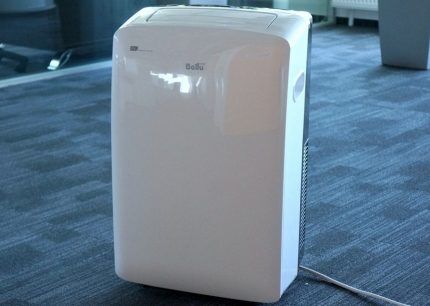
A distinctive feature of the model is its low noise level, which is relevant for all floor-standing models - only 42 dB. This is actually small, since most similar units create a specific hum during air processing.
Devices from the Platinum series can be safely installed in the bedroom or nursery. In night mode, the noise they make resembles the rustling of leaves.
The air conditioner will please everyone who values increased functionality: it copes with cooling and heating modes, and the intensity can be adjusted. Sleep mode is useful, as well as Super mode - if you need to sharply reduce the temperature to +18 ° C. The cost of the model is 18,900 rubles.
2nd place – Electrolux
The Electrolux EACM-10AG model is distinguished by its large dimensions and design.
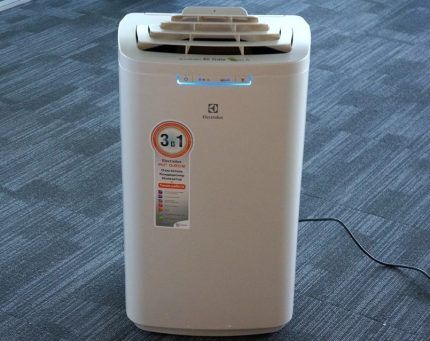
However, the rest of the details are mostly standard.
Noise level - 49 dB, cooling power - 2930 W, energy efficiency - class A. Cost - 19,900 rubles.
3rd place – MDV
The manufacturer is known for models from the Tango series; we will look at the MPGi-09ERN1 air conditioner.
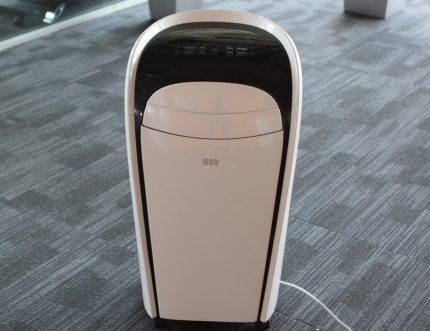
The case design is somewhat different from traditional rectangular models.
Power in heating mode – 2600 W, in cooling mode – 1000 W, noise level – 54 dB, air flow volume – 6.3 m³/min. Cost – 23,500 rubles.
4th place – Timberk
The most compact option of the five is the Timberk AC TIM 09H P4 model.
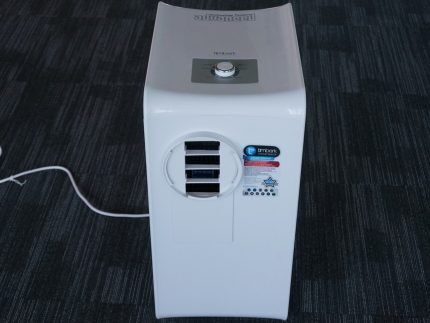
To install the device, you need a small space near the window.
Cooling/heating power – 2600 W, noise level – 21 dB, energy efficiency class – B. Cost – 21,500 rubles.
5th place – Bork
A model that has a high price is Bork Y502.
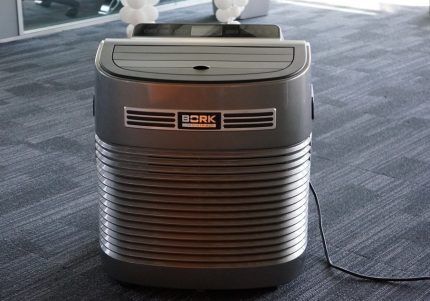
The advantage of a fairly powerful unit is its small dimensions.
Cooling power - 2600 W, noise level - 50 dB, energy efficiency class - A. Cost - 33,600 rubles.
We present videos with useful information to deepen your knowledge about mobile floor air conditioners.
Conclusions and useful video on the topic
How to make a hole for an air duct in glass:
Review of the TM Carrier model:
As you can see, the range of floor-mounted climate control equipment is quite large. To choose an air conditioner for your conditions, be sure to study the technical specifications and additional functions, and also read the installation rules.
Can't make a choice floor air conditioner? Or did you manage to purchase a new air conditioner model? Tell us what device you purchased, are you satisfied with its performance? Please leave comments in the block below.




We have a floor-mounted air conditioner in our house. It does its job perfectly: it cools the room very quickly. For its installation and operation, no additional hood on the wall of the house was required. The hot air is discharged through a large-diameter pipe directly to the street. There is a remote control to control its operation. It is easy to maintain, does not take up much space, and the price is affordable. Great item for hot weather.
When choosing between a floor-mounted air conditioner and a conventional split system, I would give preference to the first one. The fact is that floor-standing air conditioners, although noisy, are much easier to maintain. This is especially true for those who live in high-rise buildings and have to hire a tower to service the split system. By the way, almost all floor systems can also work as a heater. Moreover, they have practically no requirements for minimum air temperature, since they are located indoors.